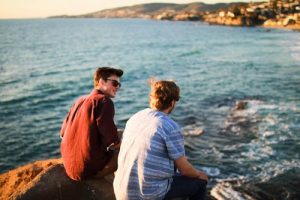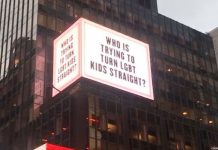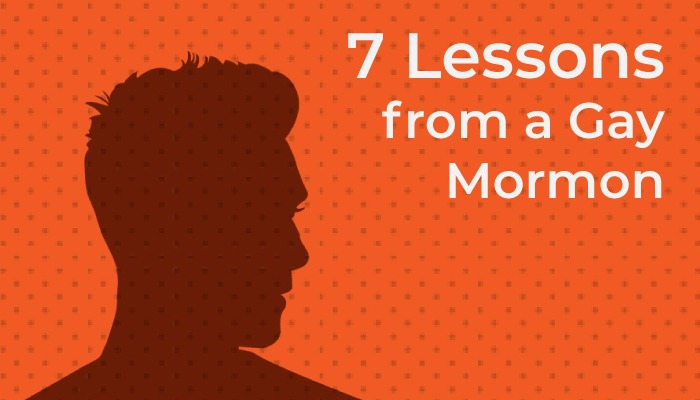
In December 2016, Lance came out on Facebook and has been “talking ever since.” God led Lance to both come out and stay in the LDS Church.
I met Lance in high school through a mutual friend. Even though Lance and I haven’t been exceptionally close over the years, being his Facebook friend has completely changed my personal understanding of what it means to be Mormon and gay. Lance exemplifies, and taught me, seven important lessons.
Although I have addressed this post mostly to friends and family members of people experiencing SSA, I want to recognize that some readers may experience same-sex attraction. I feel that Lance’s blog, his own story*, and the Church’s resources will be most helpful to them.
*These links will take you to the full transcript, full interview, and edited interview. No one tells Lance’s dynamic, beautiful story better than Lance himself.
1. It is possible to be gay and part of the LDS community.
Before Lance, I had only known “coming out” as a Latter-day Saint to mean one thing: my friend felt ready to embrace who he/she is, ready to tell the world, and ready to leave the Church in order to embrace his/her new life fully. Lance, however, came out on Facebook in December 2016 as a part of the #LighttheWorld challenge.
I remember reading his post and then re-reading it. Maybe it seemed intuitive to everyone else who read the post, but I asked myself, “So he’s doing it? He’s coming out and he’s still Mormon?” I felt both in awe and confused, that a man could both embrace his true attraction and also withhold his potential for love and intimacy in favor of an LDS lifestyle.
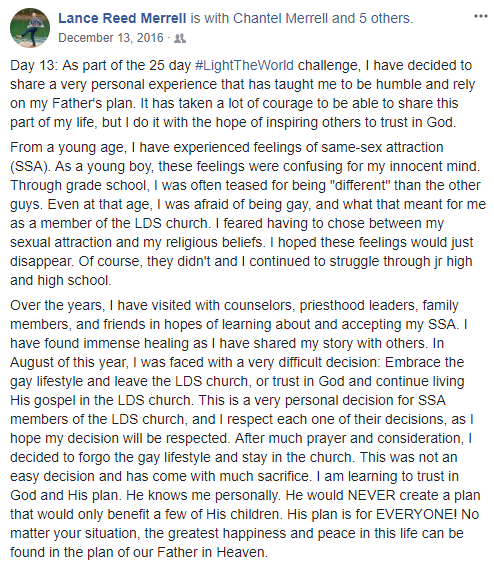
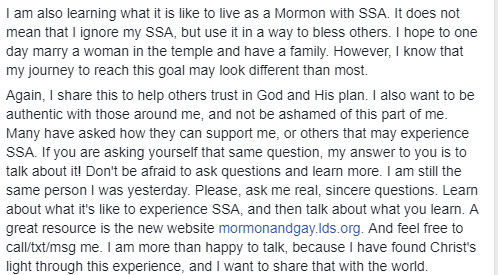
2. Our LGBTQ friends and family need our support after they come out.

For people experiencing SSA who have come out and are committed to staying in the Church, the most difficult part of their journey may lie ahead of them. They may be met with rejection by people who don’t understand them. Further, they have given up a life of intimacy and companionship to be loyal to their eternal path.
For Lance, his challenges came in the form of communication:
“How do I talk about this without obsessing over it?”
He loves sharing his experiences, but sharing so often can be emotionally draining.
Another challenge, ironically, “is knowing how to bring it up.” He explains, “When I came out publicly everyone in my circle of influence knew. But since then I’ve made new friends. I’ve made new acquaintances and new connections.” Because of that, it’s felt easier and safer to retreat back into his closet, “where it’s warm and dark and safe…But there’s no growth for me there.”
Because life gets even harder for our friends after they come out, it is so important for us to continue providing support. We may assume the most difficult part of their journey is over, but coming out is a process. Regardless of how much time has passed between their public coming out event and the present, we can safely assume our friend’s challenges haven’t ended.
3. We can refer our friends and family members to helpful resources.
When Lance was in the process of deciding whether to stay in the Church and was wrestling with the idea of coming out, he found NorthStar. Although not affiliated with the Church, NorthStar provides a safe place for LDS people experiencing SSA. The Executive President of NorthStar is Ty Mansfield, an advocate of LDS and LGBTQ communication. He has received a great deal of attention over the years for openly experiencing SSA and later marrying a woman.
Lance also discovered the Church’s website that discusses SSA. He commends the Church’s progressive way of handling these sensitive issues, as reflected in the Church changing the titles from Mormons and gays to Mormon and gay. Simply losing the “s” at the end of each word signifies that the Church recognizes that many Mormons experience same-sex attraction. Lance expresses the updated website, “has been really helpful for me because it seems to be more focused on the members of the Church, and especially those experiencing SSA…find support and find that we’re not alone.”
Lance often finds himself returning to Jessyca’s story on the website. Her experience motivated Lance to consider coming out, and has comforted him since coming out.
4. Our LGBTQ friends not only share for their own healing, but also share to help others.
Lance’s mission in life, he feels, is to not only share his experiences for himself, but also to share them to help other people. After he came out in December last year, he began sharing LDS articles about SSA (same-sex attraction) on Facebook, he wrote poignant posts, and recently, he started a blog.
Almost a year after he came out, Lance realized that he missed writing and wanted to start a blog. The thought immediately came to him to write about his experience with same-sex attraction, but he “pushed it to the side,” not wanting to become “white noise.” The thought tugged at him again and again. I’ll let Lance tell the rest of the story himself:
“Eventually, I was with a friend at dinner. (I told her) ‘I don’t want to write about this, but I keep feeling like I need to.’ And she said, ‘There are a lot of gay bloggers out there. But for (LDS YSA), you’re probably gonna be the one and only. You need to understand something. Before I met you, I knew little to nothing about this subject. My knowledge was very limited. And since meeting you, I have learned so much and gained so much understanding, and realized it is a personal experience and it is a spectrum of experiences. I needed to learn that from you, and from your voice, and your experiences. so yeah, there are a lot of voices out there, but people need to hear your voice.'”
That conversation led to Lance starting his blog. He always prays before he chooses a topic. He asks God to help him know what to write about, and also to know who he is writing to. Each time he writes a blog, he has someone reach out to him, telling him that his blog is exactly what they needed. Lance realized through these experiences that his same-sex attraction “isn’t something that’s evil or bad, but…is something that can have positive effects in my life and in the lives of others.”
5. We can all work on being more aware of the way we phrase things.
How many of us still fall into the juvenile trap of calling something “gay” when we think it is stupid? We may not even think about using the label gay in derogatory ways, but it could hurt people around us without us even knowing it.
Lance has taken it upon himself to help his friends and roommates to break unhealthy habits like this. He explains, “If it’s someone within my sphere of influence, I do my best to go tell them ‘Hey, what you said really wasn’t the best way to go about it. This is how it made me feel. This is what you can do next time.'” He feels a duty to be patient and also to educate those around him so that people say offensive things less often, for his benefit and for theirs. Lance believes that every person is on their own journey.
everyone is on their own journey. Some people are ahead of me, some people are behind me. neither is right or wrong, we’re all just on different parts of our journey. so, when someone says something out of ignorance, or offense, or hurt feelings, I do my best to just let it go. Let them say it, let them feel it, and then just kind of realize that they’re on their journey.
While we may have friends like Lance who are willing to tell us when something we said was hurtful or offensive, other friends are less accustomed to sharing how they feel. In this case, we can open the conversation by asking them if anything we say flippantly offends or hurts them. This simple gesture may help them realize that even if we don’t say things right the first time, we are trying and we are willing to be corrected.
6. Responding positively to someone coming out can impact and empower those experiencing SSA.
Lance’s coming out experience has had its challenges, but Lance expressed time and time again that nearly every time he has come out to someone, he has been met with “positive feedback and positive reactions.”
Once he “started seeing that people want to know about this, people want to learn, people want to hear about my experience,” he felt empowered to keep sharing. I have noticed a more destructive pattern among my friends who were met with anger and shame by those close family members and friends they first came out to. Being met with shame only reaffirms the shame those experiencing SSA may already experience on a daily basis.
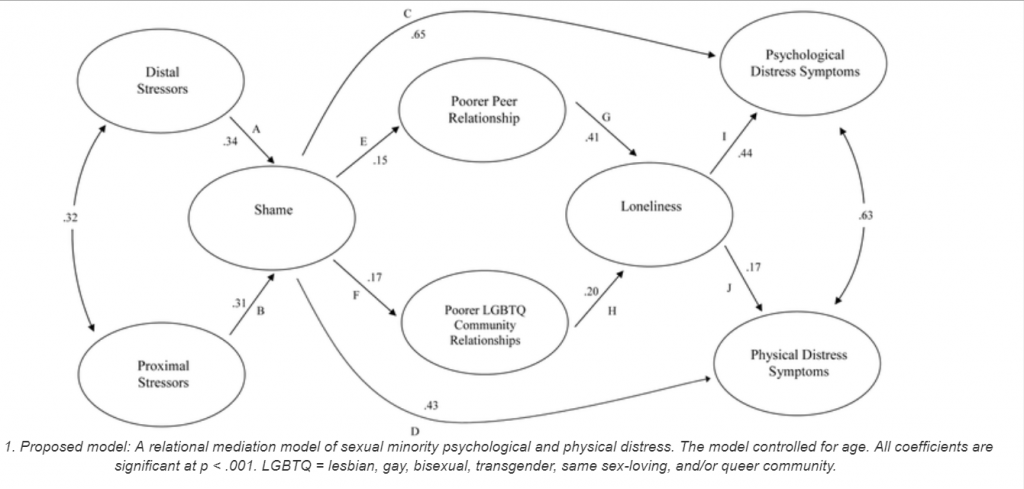
Even if we don’t understand what our friends are going through, we can still be a safe place for them. Doing so will help them embrace and love who they really are.
7. We all need to learn how to talk about this.
Straight, gay, bi, whoever you are, we all need to learn to talk about this experience. those in the heterosexual spectrum need to learn how to ask questions and how to listen And how to be supportive.And how to be supportive. And us in the LGBT community, we need to learn how to listen and let others kind of make mistakes and say the wrong things, and we need to learn how to teach. We need to learn how to instruct and share and not shame others for making mistakes, for trying to talk about it and not saying things the right way.
We just need to be patient.
Lance told me about a positive experience he had with his institute teacher. His Eternal Families class had two back-to-back lessons about marriage between a man and a woman, and then about same-sex attraction and gender dysphoria. Lance took initiative by coming to his by going to his teacher’s office a few weeks before these classes. He explained his situation and offered to share as much or as little as his teacher wanted him to.
Not only did his teacher ask him to share during the lesson, but he also took Lance aside after the lesson and asked him how the lesson went. The teacher asked if he said anything offensive and what he could do to improve.
Lance shared a few thoughts with him. More importantly, Lance left feeling that his perspective was understood and valued. We can help our friends feel heard as well. All we have to do is ask the right questions.
The Savior has a Place for Everyone
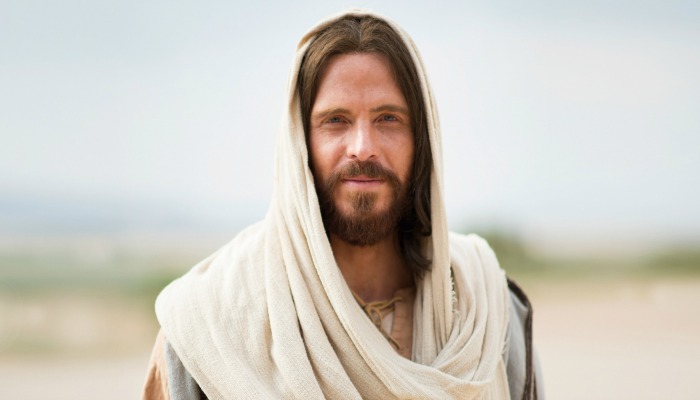
Something that has captured my attention in the past few weeks is the concept of ambiguity. There are plenty of unanswered questions, even within our truth-seeking Church. That doesn’t mean the Church is untrue. Rather, it means that God knows we need to figure out how to trust Him. He trusts us to trust Him anyway. And He trusts us to make do with what we’ve got.
The Brother of Jared had a problem—no light for his boat. He had to come up with the solution. Sometimes all we can muster up for a solution is a pile of rocks, but God makes our offering beautiful. Lance’s story teaches me that God can give anyone—faithful or not—an insoluble pill to swallow. He told Lance to figure out a solution. Lance gave his offering.
God made it beautiful. He used Lance’s offerings of his coming out, his blog, and his love for others as ways to help other people come closer to Christ. To find healing.
Each person who experiences same-sex attraction has a different, nuanced experience. Their experiences and pain are not surprising to an all-wise, all-loving, and all-knowing God. He not only knows about them, but He also knows the best ways to handle them. His greatest desire is to care for His children, especially those who feel lost and unwanted. Ultimately, Lance expresses, “My message is that no matter who you are, or what situation you are in, you can find true and everlasting happiness through the eternal plan of our Father, and we receive the strength and ability to do so through our Savior and His Atonement.”


